Strategy of pacemaker and electrode replacement for superior vena cava stenosis
- PMID: 33445982
- PMCID: PMC7812412
- DOI: 10.1177/0300060520945170
Strategy of pacemaker and electrode replacement for superior vena cava stenosis
Abstract
Cardiac implantable devices are commonly used for superior vena cava stenosis, but there have been few reports of electrode replacement in the stenosed superior vena cava. A 73-year-old man was diagnosed with second-degree type II atrioventricular block and a permanent dual-chamber, rate-modulated pacing pacemaker was implanted 10 years previously. Because of depletion of the pacemaker battery and an increase in the ventricular pacing threshold, replacement of the pacemaker and ventricular electrode was required. During the operation, we found that the patient had severe superior vena cava stenosis on angiography, and this caused obstruction when a common guidewire was used to pass through the superior vena cava. After attempting various methods, we successfully passed through the vascular stenosis with a super slide guidewire and a long sheath, and completed replacement of the pacemaker and ventricular electrode. We summarize the related literature of superior vena cava stenosis related to a cardiac implantable device, and discuss the replacement strategy of this complication and other treatment options.
Keywords: Superior vena cava stenosis; arrhythmia; atrioventricular block; cardiac implantable device; guidewire; pacemaker electrode.
Conflict of interest statement
Figures






References
-
- Zhang C, Gao Y, Zheng J, et al. A case of cardiac resynchronization treatment of defibrillator by implantation of severe stenosis of superior vena cava. Chinese Journal of Cardiac Arrhythmias 2014; 18: 233–234.
-
- Sun G, Shen F. Cardiac resynchronization for multiple occlusion of superior vena cava. Chinese Journal of Cardiac Arrhythmias 2013; 17: 467–468.
-
- Xu S, Feng G, Chen Z. Application of long artery sheath in pacemaker installation for patients with superior vena cava stenosis. Journal of Clinical Medicine in Practice 2011; 15: 60–61.
-
- Vidyasagar R, Sudarshan, Singh RN, et al. Upper extremity deep venous thrombosis and stenosis after implantation of pacemakers and defibrillators; A prospective study. Rom J Intern Med 2017; 55: 139–144. - PubMed
Publication types
MeSH terms
LinkOut - more resources
Full Text Sources
Other Literature Sources
Medical

